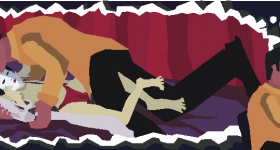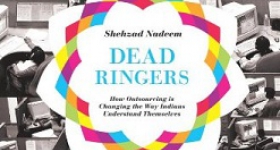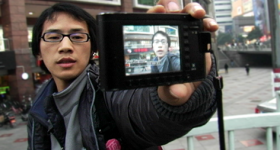AURORAE KHOO'S play Fayette-Nam is a story about a young black soldier who gets caught in a love triangle with a 40-year-old Asian American woman and her daughter. Afraid of going to Iraq, the soldier goes absent without leave and takes refuge in the doughnut shop run by the women in Fayetteville, NC. Both women fall in love with him, and at the same time, they harbor racist views toward black people and must deal with their conflicting emotions.
But the fact that the women are Asian American is only an accessory to the story, says Duy Nguyen, co-artistic director of San Francisco's Asian American Theater Company, which produced the play, a dark comedy that premiered in June. The story does not revolve around them being Asian American, and unlike conventional Asian American plays where white racism is the focal point, the women's attitudes toward the black man are explored.
Today, it seems that Asian American theater is moving past stories about generation gaps, culture clashes and finding identity - topics that pioneers like David Henry Hwang and Philip Kan Gotanda made the centerpieces of their plays in the 1970s and 1980s. In Hwang's first play, F.O.B., the culture clash between a new Chinese immigrant and a Chinese American is explored, while his third play, Family Devotions, shows the conflict between East and West within three generations of a Chinese American family. Contemporary Asian American plays are tackling new takes on Asian American life, and even the definitions of Asian American theater are expanding.
"The original way Asian American theater manifested itself was through very political pieces that explored what it means to be Asian American, specifically addressing identity," says Darryl Chiang, interim executive director of the Asian American Theater Company. "[Today,] that's not the most important issue."
From a handful of theater companies in the '70s, there are now at least 80 active Asian American theater groups nationwide, according to the Asian American Theatre Revue website. Many groups and performers are experimenting with genres such as comedy, improv and solo shows, which were unheard of 30 years ago. As artists gravitate toward nontraditional genres and venues, even within Asian American theater, a defiance of traditional themes is occurring.
As part of this evolution, new types of plays are emerging with characters who are Asian American in stories that don't focus on being Asian American. They are more about the individual experience, as in Fayette-Nam or Naomi lizuka's 36 Views, which explores the line between the real and imaginary through the encounter of a fake antique in the Asian art world, involving both white and Asian American characters. Another example is Diana Son's Stop Kiss, about two women who become lovers, one of whom was played by Sandra Oh at The Public Theater in New York. Son wrote the play without racially specifying the roles, yet requested diversity in casting.
"It's still trying to get across what being Asian American is, but it's through a different lens," says Jeff Liu, literary manager at East West Players. "Rather than historical-political, it's through pop culture, modern urban neurosis. It's existential."
Lauren Yee, who wrote the play Ching Chong Chinaman, has seen many Asian American actors looking not toward the future but to the past - to Shakespeare. Because authences are familiar with Shakespeare's plays, Yee says, multicultural casts are not seen as disturbances to the storyline.
"That's the only place authences are OK with a multicultural cast, like seeing an Asian daughter with a white father," she says.
Impact Theatre in Berkeley, CA, produced Ching Chong Chinaman in 2008, and Yee says she was pleased to work with a non-Asian American company. "To be able to work with theaters that are interested because you tell a good story, and not because you're Asian American, is great."
One group in New York is approaching Asian American theater in a completely different way, using only Asian American actors in non-Asian American plays. National Asian American Theatre Company, founded In 1989, only produces European and American classics, adaptations of these classics by Asian American playwrights and new plays written by non-Asian Americans. Though the company has at times received criticism for not producing Asian American plays, co-founder Mia Katigbak sees it as a unique way of positioning her company in a city filled with other Asian American theater groups, such as Ma-Yi Theater Company and Pan Asian Repertory Theatre.
National Asian American Theatre recently premiered Leah's Train, a play about a Russian Jewish American family coming to terms with the past. Katigbak says that using Asian American actors in roles not written as Asian shows the universality and common ground between different cultures. "It says Asian Americans are capable of understanding other Americans and the way the world is."
Yet Katigbak sometimes hears ignorance in the surprised attitudes of the authence. She recalls when they did a play by Anton Chekhov, authence members were surprised. "What, you don't think Asian Americans understand Chekhov?" she says.
Liu says these changing forms are progress, but, although it may seem counterintuitive, nontraditional Asian American plays are less likely to cross over to mainstream theater if they are less race focused. "If Asian American plays cross over, it will tend to be plays that explain Asian America. It won't be the most edgy stuff."
While these contemporary plays may not connect with mainstream authences, Asian American theater is gaining some non-Asian converts. At East West Players, founded in Los Angeles in 1965, just 54 percent of its ticket buyers are Asian American, according to Tim Dang, the group's artistic director.
"I look at it like food - these days, people are more diverse," Dang says. "People go eat Chinese food, Thai food, Indian food. I'm hoping people's tastes are going to be more like that in the future."
Rick Shiomi, artistic director at Mu Performing Arts in Minneapolis, says that previous mainstream authences saw Asian American plays as having little relevance to them. But now he says, "People are beginning to see that this play about an Asian American family has more universal appeal about American life, human behavior and family relationships."
He says that Mu has a unique focus because Minnesota has over 10,000 Korean adoptees, many of whom have worked with Mu, bringing a unique perspective on Asian American identity.
"I think that Asian American theater is re-emerging with a new kind of energy, with a newer wave of artists, bringing new ideas," Shiomi says.
Silk Road Theatre Project In Chicago is an example of this new wave. The company seeks stories that are inclusive of many backgrounds, especially those with a South Asian perspective, which historically has had a small presence in Asian American theater. Jamil Khoury and Malik Gillani founded the company as a response to 9/11 and the resulting anti-Arab and anti-Muslim sentiments. The company's mission is inspired by the cultural exchange that occurred through the ancient Silk Road trade route, and it wants to create the same intercultural dialogue by producing plays about people from Asia, the Middle East and the Mediterranean.
Khoury says that in the past Asian American works have been based on narrow definitions of who is Asian American. "To us, that's not the full story," he says.
Khoury, who is half Syrian and half white, says that as a part-Arab American, he doesn't identify as Asian American because he's been told he's not.
"Essentially, Islamic Asia is not seen as part of the rubric, but we really want a Japanese person to think of their self in relation to a Pakistani person, an Italian person to think of their self in relation to a Korean," he says. "We want to create connections and conversations."
In doing so, Khoury has found that Asian America is divided. He recalls the first time his company did a play featuring Japanese American characters, he tried to reach out to the Korean, Chinese and Filipino community. "People said, 'We hate the Japanese. Why would we see that?' " he says. "It was very clear that they felt they didn't relate to each other. So we have political identity categories that become important when trying to fight for rights, but within that, there are a tremendous amount of divisions."
The South Asian theater community is working to bridge these divisions. In 2007, the South Asian theater groups and artists gathered for their first conference, and met again in 2008. Khoury says the hope is to not only have a South Asian voice, but to find a place among Asian American theater and American theater. But he acknowledged that the endeavor has been challenging.
"It may be uncomfortable to the older people of Asian American theater who have an established definition of what is Asian American," Khoury says. "It's powerful to see East Asian communities being told they're not being inclusive, being told that this notion of Asian-ness needs to be rethought."
Philip W. Chung, co-founder and artistic director of Lodestone Theatre Ensemble of Los Angeles, also says Asian American theater companies need to expand and be more open-minded about what is considered Asian American. He says that if he were to write a play about 18th-century England, it would be rejected as not Asian American, even coming from an Asian American playwright.
"Throughout history, white writers have had the freedom to write about whatever they want, so Asian Americans should have that freedom too," Chung says.
Lodestone Theatre Ensemble was founded specifically to challenge the definitions of Asian American theater. It has produced plays written by white writers, cast with Asian Americans, Asian folktales with both Asian and white actors, and plays on topics that are universal, such as violence in America.
"From the beginning, we took the question of 'what is Asian American' off the table," Chung says. "The fact that we want to do it makes it Asian American."
But after 10 years of groundbreaking work, Lodestone is closing in the fall.
"We were at a point where we felt we've done as much as we could creatively in our current incarnation ... We're financially strong and can keep the theater going like this forever but it really was a creative decision - the idea that It's better to go out when you're at your creative peak," Chung says.
Chung thinks that Lodestone has helped expand the definitions of Asian American theater but he says more can be done.
"If we want a real movement, we have to be able to collectively push boundaries," he says. "We've become a culture of victims. We talk about not getting our fair share of the pie. At some point it becomes a self-fulfilling prophecy and provides comfort. I want people to say, 'Screw that, let's fight against that.' "
While it remains to be seen whether the dialogue will change, Asian American theater is beginning to unify itself. Three years ago, the Consortium of Asian American Theatres and Artists was founded to connect Asian American theater organizations scattered across the country. Since 2006, the group has held two conferences and the first national Asian American theater festival. The second festival will be held In October in New York.
This network is necessary for Asian American theater artists to collaborate to build the visibility of Asian American theater and validate it in this country, according to Dang of East West Players.
"All of us did well before we met each other, but as a solid, cohesive group, we can make things move faster, and make more of an impact," Dang says.
Steffi Lau is a student at the University of Southern California.









Comments